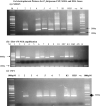Age-dependent carriage of alleles and haplotypes of Plasmodium falciparum sera5, eba-175, and csp in a region of intense malaria transmission in Uganda
- PMID: 33032613
- PMCID: PMC7543040
- DOI: 10.1186/s12936-020-03432-0
Age-dependent carriage of alleles and haplotypes of Plasmodium falciparum sera5, eba-175, and csp in a region of intense malaria transmission in Uganda
Abstract
Background: The development of malaria vaccines is constrained by genetic polymorphisms exhibited by Plasmodium falciparum antigens. The project the age-dependent distribution of alleles or haplotypes of three P. falciparum malaria vaccine candidates, Circumsporozoite Protein (csp), Erythrocyte Binding Antigen 175 (eba-175) and Serine Repeat Antigen 5 (sera5) in a region of intense malaria transmission in Uganda.
Methods: A cross-sectional study was carried out between August and November 2009 in which 250 study participants were selected from a population of 600. Finger prick blood samples were collected after informed consent from participants below 5 years, 5-10 years, and above 10 years of age. Blood was used for microscopy, RDT and dried blood spots. Plasmodium falciparum DNA was extracted by chelex method. Alleles of sera5 and eba-175 were determined by polymerase chain reaction (PCR) amplification followed by resolution of products by agarose gel electrophoresis. Allele calling was done using gel photographs from ethiduim bromide stained gels. Haplotypes of csp were identified by sequencing 63 PCR products using the P. falciparum 7G8 laboratory strain sequence as a reference. The data were analysed using SPSS 16, EQX for windows and Chi-square test was used to calculate associations (P-values), Excel was used to generate graphs. The BioEdit and NCBI blast software programs were used to analyse the sequences from which csp haplotypes map was constructed.
Results: Eba-175 FCR3 (48/178) and CAMP (16/178) alleles were observed, the FCR3 (24/67) allele being predominant among children aged below 5 years old while the CAMP (12/67) allele was predominant among older participants. Sera5 alleles ORI (6/204) and ORII (103/204) were observed in the population, ORII was more prevalent and was significantly associated with age (P values < 0.0001), parasite density (P-value < 0.0001) and clinical outcomes (P value = 0.018). There was marked csp diversity in the Th2/Th3 region. Out of 63 sequences, 16 conformed to the reference strain and one (1/16) was similar to a West African haplotype and the majority (14/16) of the haplotypes were unique to this study region. There was an age-dependent distribution of csp haplotypes with more haplotypes being harbored by children < 5-year of age, (10/16) compared to adults (2/16). Interestingly, the csp haplotype corresponding to 3D7 whose prototypical sequence is identical to the sequence of the leading malaria vaccine candidate RTS, S was not observed.
Conclusion: This data suggest that the eba-175 FCR3 allele, sera5 ORII allele, and csp haplotypes are targets of host immunity and under immune selection pressure in Apac District. These molecules could provide alternative malaria vaccine candidates as sub-unit vaccines.
Keywords: Immunogenicity; Malaria vaccines; Plasmodium falciparum; Polymorphisms.
Conflict of interest statement
The authors declare that they have no competing interests
Figures









References
-
- World Health Organization . World malaria report. Geneva: World Health Organization; 2019.
-
- CDC. Malaria control in Uganda. In: Towards the Abuja targets. Atlanta. 2004.
MeSH terms
Substances
LinkOut - more resources
Full Text Sources
Research Materials

